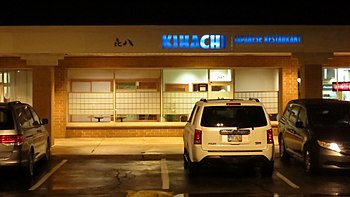Contents

There is a Japanese community in the Columbus, Ohio area.
The presence of Honda Motor Company and related suppliers attracted a population of Japanese expatriates to the Columbus area. In 2011 Bill Daley of the Chicago Tribune stated that "the international pull of Ohio State University" adds to the "real discernible Japanese flavor to" Columbus.[1]
History
Honda first established operations in Marysville in 1979. Japanese people began living in Dublin and other suburbs instead of Marysville because Dublin established a support system for Japanese residents and the suburbs offered Saturday schools for Japanese residents. Therefore, as of 2013, few Japanese lived in Marysville.[2]
In 2012 Columbus received twenty cherry trees from the Japanese government and they were scheduled to be planted at the Franklin Park Conservatory and Botanical Gardens on April 27 of that year.[3]
Demographics
Of all regions of Ohio, central Ohio has the largest Japanese national population.[4] According to the "2013 Japanese Direct Investment Survey" by the Consulate-General of Japan in Detroit, Dublin had 2,002 Japanese nationals and Columbus had 705 Japanese nationals,[5] giving those cities in the highest such populations in the state.[4]
As of the 2010 U.S. Census, 1,071 Japanese people live in Dublin, making up 2.6% of the city's population. As of that year, 122 Japanese live in Union County, making up 0.2% of the county's population. Holly Zachariah of The Columbus Dispatch stated that "It has been that way historically."[2]
Economy


Honda Motor Company operates the Marysville Auto Plant in Marysville and the East Liberty Auto Plant in East Liberty. There are also Honda operations outside of Columbus, including an engine plant near Anna and a transmissions operation in Russells Point. In addition there are suppliers serving Honda in the Columbus area.[6] As of 2011, a total of 83 Japanese companies have operations in Greater Columbus.[7]
Education
A RE/MAX real estate agent named Akiko Miyamoto (宮本亜希子 Miyamoto Akiko) stated in Car Talk that the services provided for Japanese speakers by the Dublin City School District attract Japanese expatriates to Dublin.[6]
The Columbus Japanese Language School, a weekend supplementary Japanese school, serves the area.[8]
Culture and recreation
Each year the city holds the Asian Festival. Over 100,000 people come to the festival annually. In addition, the Billy Ireland Cartoon Library & Museum at Ohio State University has the largest collection of manga that is not in Japan.[1]
In 2011 Daley wrote that "The number of Japanese restaurants in and around Columbus ranges from 19 to at least 40, depending on who's counting, and there are dozens more if you tally restaurants under a generic "Asian" theme."[1] Daley stated that Kihachi (㐂八[9] or 喜八;[10] "㐂" means "喜" or "happy"), a restaurant in Northwest, Columbus, was "so highly regarded" to the point that it was featured in an episode of Anthony Bourdain: No Reservations.[1] In that episode, Anthony Bourdain and Michael Ruhlman visited Kihachi.[1] The restaurant closed in 2018 as the owner decided to retire.[11]
The Columbus Japanese Women’s Chorus (はなみずきの会[12] Hanamizuki no Kai "dogwood group") includes members of the Japanese community.[13] It was founded in 1995. The group name is a reference to the dogwood trees given to Japan by the United States.[14]
References
- ^ a b c d e Daley, Bill. "East meets Midwest." Chicago Tribune. November 15, 2011. p. 1. Retrieved on June 13, 2014.
- ^ a b Zachariah, Holly. "Marysville seeks to deepen links to Japan" (Archive). The Columbus Dispatch. Monday December 9, 2013. Retrieved on June 14, 2014.
- ^ McKinsey, Rebecca. "Trees will represent blossoming relations" (Archive). The Columbus Dispatch. Tuesday April 10, 2012. Retrieved on June 14, 2014.
- ^ a b Eaton, Dan. "Japanese companies added 2,700 Ohio jobs in 2013, survey finds." Columbus Business First. March 10, 2014. Retrieved on June 13, 2014. "Central Ohio does lead in the number of Japanese nationals living in the state. Dublin, with 2,002, and Columbus’ 705 are home to the state’s two largest populations of Japanese nationals."
- ^ "2013 Japanese Direct Investment Survey: Summary of Ohio Results (as of October 1, 2013)" (Archive). Consulate-General of Japan in Detroit. March 5, 2014. Retrieved on June 17, 2014.
- ^ a b Motavalli, Jim. ""Little Tokyo": Japanese Honda Familes [sic] Adjust to Life in Ohio" (Archive). Car Talk. June 28, 2013. Retrieved on June 13, 2014.
- ^ "Dublin Cares about Japan Archived 2016-03-04 at the Wayback Machine" (Archive). City of Dublin. Retrieved on June 13, 2014.
- ^ English information Archived 2014-05-12 at the Wayback Machine (Archive). Columbus Japanese Language School. Retrieved on May 9, 2014.
- ^ From a photograph of the restaurant here (Archive)
- ^ "旅先のレストラン" (Archive). Indiana Japan Chamber (インディアナ州日本人会). Retrieved on October 6, 2014. "喜八 OH 2667 Federated Blvd Columbus, OH"
- ^ "Food News: Kihachi's last day is Saturday, Dec. 15; The Lox Bagel Shop opening soon". Columbus Monthly. 2018-12-12. Retrieved 2023-08-19.
- ^ "当館の主な活動報告" (Archive). Consulate-General of Japan in Detroit. Retrieved on June 14, 2014.
- ^ Zachariah, Holly. "Ohio’s support after tsunami touched Japan" (Archive). The Columbus Dispatch. Thursday October 27, 2011. Retrieved on June 14, 2014.
- ^ "Columbus Japanese Women's Chorus (Hanamizuki no Kai) Archived 2014-07-15 at the Wayback Machine" (Archive). Ohio State University. Retrieved on June 14, 2014.
External links
- Japan-America Society of Central Ohio (JASCO) Sentoraru Ohaio Nichibei Kyōkai (セントラルオハイオ日米協会)
- Columbus Japanese Language School (in Japanese); English Information at WebCite (archived 2014-05-09)
- Honda of America Manufacturing, Inc.
- Asian Festival
- Japanese Student Organization (JSO) オハイオ日本文化会 (Ohaio Nihon Bunka Kai, Ohio Japanese Culture Association) at Ohio State University

